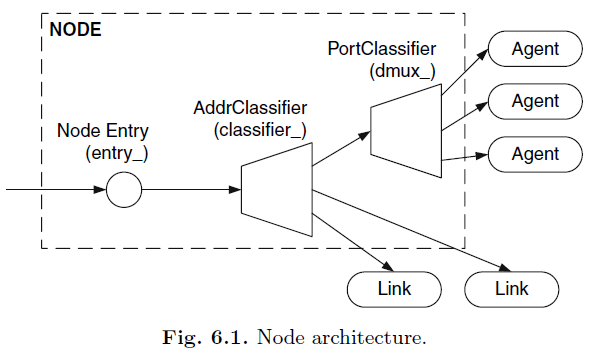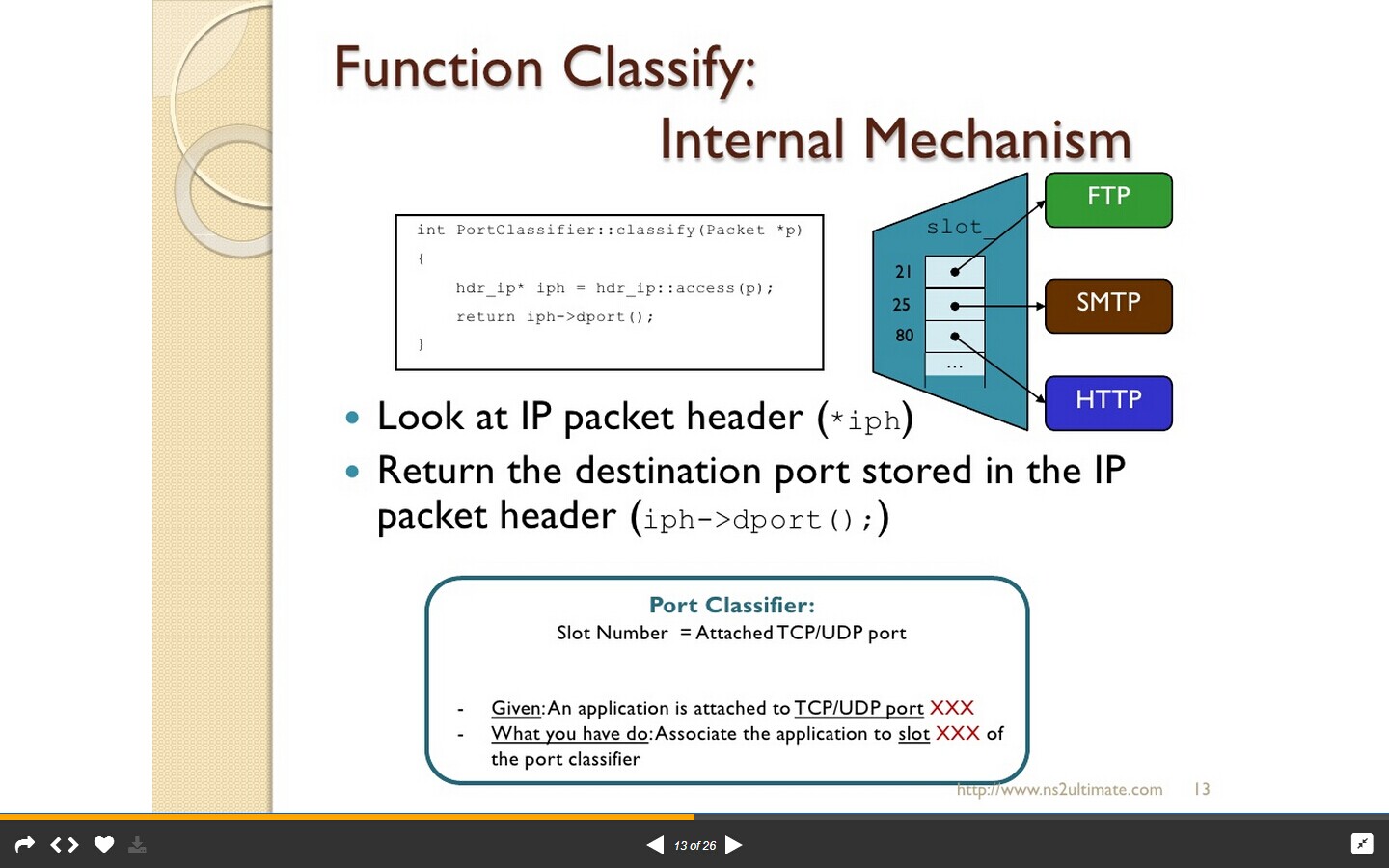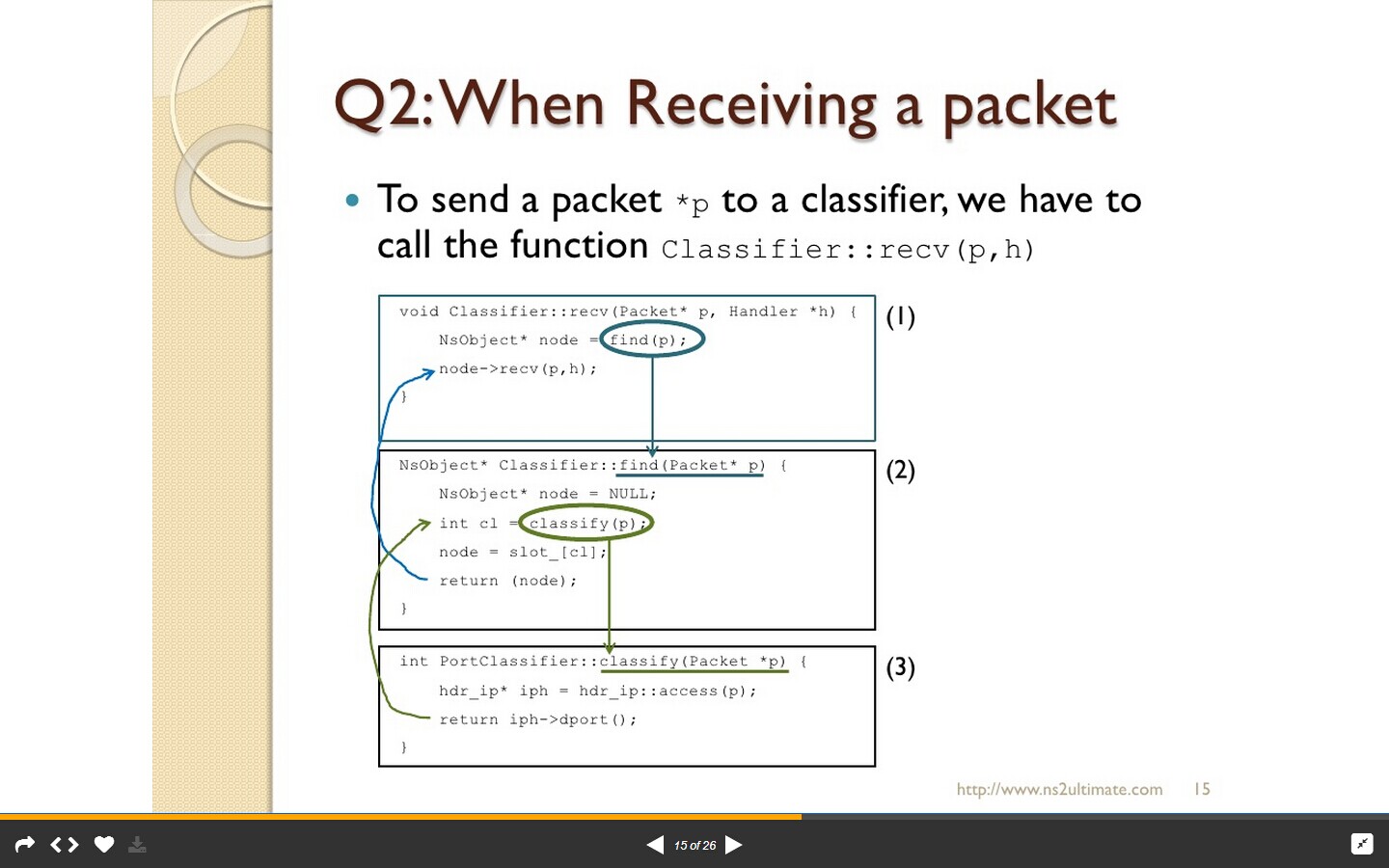classifier.cc-recv() [ns2.35]

//without comments int chooseECNSlot()
{
double maxProgress=;
for(int i=;i<=nslot_;i++)
{
if(slot_[i]!=NULL && window_i>*count)
{
double ti=window_i/(*count);
double iProg=umap[slot_[i]]+(window_i+ti/)*ti;
for(int j=;j<=nslot_;j++)
{
if(slot_[j]!=NULL && window_j>*count)
{
double jProg=umap[slot_[j]]+(window_j+ti/)*ti;
if(jProg>iProg) break;
}
if(j==nslot_)
{
return i;
}
}
}
}//for
return -;//no flow satisfies the condition.(maybe should return the flow with max progress)
} int PortClassifier::recv(Packet* p, Handler*h)
{
NsObject* node = find(p);//find调用classify,classify返回dport。
if (node == NULL) {
Packet::free(p);
return;
} umap[node]++; if(flag)
{
hdr_flags *hf=hdr_flags::access(pickPacketForECN(p));
if(hf->ce()==)
{
hf->ce()=;
mark=chooseECNSlot();
}
if (mark != - &&node==slot_[mark])
{
hf->ce()=;
mark = -;
}
}//end of flag node->recv(p,h);
} void PortClassifier::install(int slot, NsObject* p)//install是用来向slot里赋值的。(连接agent & slot)
{
if (slot >= nslot_)
alloc(slot);
slot_[slot] = p; if (slot >= maxslot_)
maxslot_ = slot; count++;
if(count>=)
flag=; } ================================================================================================================================== 15.1. rewrite: classifier-port.h里需要添加的:
()include处
#include <unordered_map> 还要using namespace std?或者不用?在底下定义的时候用std::unordered_map<NsObject*,double> umap
#include "flags.h"//里面有很多需要的变量和函数,如ce()
()3个变量
count=; flag=; mark=-;//可以考虑用复杂些的变量名,防止别的需要include的文件里有重名的
count不止表示agent个数,同时它是server的个数!
flag用来标志receiver; //【但是这样全局变量对吗?sender那边如果使用portclassifier时会累加上吗?不会的。这方法可以。亲测有效。】
//【如果不行就用遍历slot的方法。每次遍历一下看有多少agent。】
()
unordered_map<NsObject*,double> umap;//看看用不用指定std:: ------------------------------------------------------------------------------------------------------------------------------
//with comments int chooseECNSlot()//根据umap里的统计来获取各流进度值。返回值是slot_的下标。
//这个函数还是改成专门筛选流的函数吧(筛选出需要窗口减半的流)
{
//该函数需要能访问到umap以及各流的window大小。
//注意:这里说的按进度排序不是按当前进度排序,而是按下次发生ECN的时刻的进度排序。 double maxProgress=;//初始化最大进度值maxProgress
// mark=-1;//用来标记选中的流
// int flagMax=0;
for(int i=;i<=nslot_;i++)//下标能否等于nslot?
{ //其实遍历slot就行!slot_中有一些是empty,所以虽然知道共有count个agent,还是得完整遍历一遍slot_.
if(slot_[i]!=NULL && window_i>*count)// 这是能“参赛”的流的入门条件。
{//在window大于2N的流里面找[下次ECN时刻]进度最大的。
//这里count就是server数目N。
//ASSUME flow with index[i] will be the maxProgress-flow at next ECN
double ti=window_i/(*count);//the time gap from now when next ECN happens
int newProg=umap[slot_[i]]+(window_i+ti/)*ti;
for(int j=;j<=nslot_;j++)
{
if(slot_[j]!=NULL && window_j>*count)//参赛门槛
{
double tj=window_j/(*count);
tmpProg=umap[slot_[j]]+(window_j+tj/)*tj;
if(tmpProg>newProg) break;//说明i不是下次ecn时进度最快的,假设不成立。
}
}
// if(umap[slot_[i]]>maxProgress)
// {
// maxProgress=umap[slot_[i]];//更新maxProgress
// mark=i;//标记下该流的node在slot_中对应的下标i;
// }
} // else
// {//如果没有window>2N的流,就选当前进度最大的流?这是后话。
// } }//for // if(mark!=-1)
return mark;// 返回下标
// else//没有window>2N的流
// return mark2; } //////////////////////////////////////////////////////////////////////////////////////////////////////////////////////////////////// int PortClassifier::recv(Packet* p, Handler*h)
{
NsObject* node = find(p);//find调用classify,classify返回dport。
if (node == NULL) {
Packet::free(p);
return;
} if(flag)//当前node是receiver时才执行下面的算法。
{
// mark=-1;//slot_下标的初始值置为-1?
umap[node]++;//需要在classifier.h中classifier类内部定义unordered_map umap<NsObject*,double>。 (但是注意,当umap里有流已传输完毕后要剔除出去,否则影响排序XXXX如果不用mark2的话那就不会影响到,因为首先是按window来看的,只有window足够大才会看进度。已经传输完成的流window应该变为0吧(如果没变要记得调整))。
hdr_flags *hf=hdr_flags::access(pickPacketForECN(p));
if(hf->ce()==)// 说明switch中发生了拥塞
{
hf->ce()=;//首先清零。然后再根据算法分配ce。
mark=chooseECNSlot();//用chooseECNSlot()选出应当减半的流。
} if (mark != - &&node==slot_[mark]) //这个recv()程序一开始就用到了find,把packet转换成了agent(这里是用node变量来表示的agent)。所以可以用这个node来和slot_[mark]直接比较。
//对每一个到来的packet都检查,直到发现是mark所标记的那个。可通过portclassifier里的classify返回dport。(参照slideshare P15,为什么通过classifier类,调用的却是portclassifier里的classify ?)
{
hf->ce()=;
mark = -;//任务完成,使mark失效。
}
}//end of flag
node->recv(p,h);
} void PortClassifier::install(int slot, NsObject* p)//install是用来向slot里赋值的。(连接agent & slot)
{
if (slot >= nslot_)
alloc(slot);
slot_[slot] = p; if (slot >= maxslot_)
maxslot_ = slot; count++;
if(count>=) flag=; } ==================================================================================================================================
//below is original source code void Classifier::recv(Packet* p, Handler*h)//original
{
NsObject* node = find(p);
if (node == NULL) {
/*
* XXX this should be "dropped" somehow. Right now,
* these events aren't traced.
*/
Packet::free(p);
return;
} node->recv(p,h);
} ///////////////////////////////////////////////////////////////////////////////////////////////////// void Classifier::install(int slot, NsObject* p)
{
if (slot >= nslot_)
alloc(slot);
slot_[slot] = p;
if (slot >= maxslot_)
maxslot_ = slot;
} //above is original source code
===============================================================================================================
updated 15.1.8
void Classifier::recv(Packet* p, Handler*h)//original
{
NsObject* node = find(p);
if (node == NULL) {
/*
* XXX this should be "dropped" somehow. Right now,
* these events aren't traced.
*/
Packet::free(p);
return;
} node->recv(p,h);
} =============================================================================================================== int chooseECNSlot()
//这个函数还是改成专门筛选流的函数(筛选出需要窗口减半的流)
{//在打ecn的地方引入调用这个函数,通过该函数来打ECN?或者通过该函数有针对性的回调打ecn的函数。
//该函数需要能访问到umap以及各流的window大小。 //sort(window)其实不用。用下面的方法只需遍历一次,O(N)复杂度即可。如果sort要O(NlogN)。
int maxProgress=;//初始化最大进度值maxProgress
int mark=-;//用来标记选中的流s
for(i=;i<=n;i++)//其实遍历slot就行!
{
if(window>*N)//在window大于2N的流里面找进度最大的。(如何获取该流的window?)
{
if(该流的进度值(umap.second)>maxProgress)
{
maxProgress=该进度值(umap.second);//更新maxProgress
mark=i;//标记下该流的node;
}
}
else
{//如果没有window>2N的流,就选当前进度最大的流。 }
}
if(mark!=-)
return mark;
else//没有window>2N的流
return mark2; } ////////////////////////////////////////////////////////////////////////////////////////////////////////////////////////////////////
15.1. rewrite: #include "flags.h"//里面有很多需要的变量和函数,如ce()
void Classifier::recv(Packet* p, Handler*h)
{
NsObject* node = find(p);//find调用classify,classify返回dport。
if (node == NULL) {
Packet::free(p);
return;
}
umap[node]++;//需要在classifier.h中classifier类内部定义unordered_map umap<NsObject*,long long int>。 (但是注意,当umap里有流已传输完毕后要剔除出去,否则影响排序XXXX如果不用mark2的话那就不会影响到,因为首先是按window来看的,只有window足够大才会看进度。已经传输完成的流window应该变为0吧(如果没变要记得调整))。 hdr_flags *hf=hdr_flags::access(pickPacketForECN(p));
if(hf->ce()==)// 说明switch中发生了拥塞
{
hf->ce()=;//首先清零。然后再根据算法分配ce。
int mark=function(筛选出需要窗口减半的流的slot下标);//该函数参照上面的chooseECNSlot
} if (mark != - &&当前packet的dport==slot[mark])//对每一个到来的packet都检查,直到发现是mark所标记的那个。可通过portclassifier里的classify返回dport。(参照slideshare P15,为什么通过classifier类,调用的却是portclassifier里的classify ?)
{
hf->ce()=;
mark = -;//使mark失效。
}
node->recv(p,h);
}


http://www.slideshare.net/TBear76/20100403-classifiers
classifier.cc-recv() [ns2.35]的更多相关文章
- ubuntu 14.04 ns2.35 ***buffer overflow detected **: ns terminated解决办法
1.按照如下教程安装 Install With Me !: How to Install NS-2.35 in Ubuntu-13.10 / 14.04 (in 4 easy steps) 2.运行一 ...
- 在ns2.35下完成柯老师lab18实验
说明:柯志亨老师<ns2仿真实验-----多媒体和无线网络通信>这本书lab18实验为“无线网络封包传输遗失模型”的实验.该无线传输遗失模型是柯老师自己开发的,原始的ns-allinone ...
- 在ns2.35中添加myevalvid框架
在用ns2进行网络视频通信仿真的时候,先要为我们自己的ns2添加evalvid或者myevalvid框架.其中myevalvid框架是由柯志亨老师整合evalvid和ns2之后得出的新框架,笔者建议大 ...
- Ubuntu14.04下安装ns2.35
我选择的版本是2.35最新版本,安装环境是Ubuntu 14.04. 1.下载ns2的安装包,这里我选择的是ns-allinone-2.35.tar.gz压缩格式的all in one安装包,all ...
- Ubuntu12.04 LTS 32位 安装ns-2.35
ubuntu12.04lts 32-bit默认采用gcc 4.6和g++4.6,而ns的最新版本ns 2.3.5也采用了相同到版本,所以这方面不会有版本不同到问题 收回上面这句话..../valida ...
- Ubuntu 16——安装——ns2.35和nam
Ubuntu 16.04 安装ns2.35+nam 总结出以下安装步骤 1: 更新源 sudo apt-get update #更新源列表 sudo apt-get upgrade #更新已经安装的包 ...
- NS2安装过程中环境变量设置的问题(ns-2.35)
nam: Can't find a usable tk.tcl in the following directories: */ns-allinone-2.35/tcl8.5.10/library/t ...
- ns2.35-classifier.cc
line143:recv() /* -*- Mode:C++; c-basic-offset:8; tab-width:8; indent-tabs-mode:t -*- */ /* * Copyri ...
- NS2仿真:公交车移动周期模型及性能分析
NS2仿真实验报告3 实验名称:公交车移动周期模型及性能分析 实验日期:2015年3月16日~2015年3月21日 实验报告日期:2015年3月22日 一.实验环境(网络平台,操作系统,网络拓扑图) ...
随机推荐
- ScriptManager.RegisterStartupScript失效的解决方案
在项目中一个页面使用System.Web.UI.ScriptManager.RegisterStartupScript(this.Page, this.GetType(), "success ...
- linux下,matplotlib遇到的相关问题以及解决方法
1.在linux下运行matplotlib程序时,matplotlib的安装. 根据不同的linux系统继续相关安装: Debian / Ubuntu : sudo apt-get install p ...
- php添加mysql.so扩展
1.软件包安装 yum install php-mysql 安装的是mariadb的扩展 yum install php-mysqlnd 安装的是mysql的扩展
- 011-filter模板
1 模板一 package ${enclosing_package}; import java.io.IOException; import javax.servlet.FilterChain; im ...
- 二叉树数组C++实现
基本概念梳理 孩子:子结点 双亲:父节点 度:有多少个子结点 有序树:固定的排列的树 无序树:排列与顺序无关的树 二叉树:所有结点小于等于2的树 源代码:https://github.com/cjy5 ...
- js 屏蔽浏览器事件汇总
//js 屏蔽 window.document.oncontextmenu = function () { event.returnValue = false; }//屏蔽鼠标右键 window.do ...
- 【vm安装vmtools】
使用sudo ./安装命令 对vmware-tools-distrib文件夹里面vmware-install.pl文件夹进行安装 sudo ./vmware-install.pl
- YII框架一个请求的生命周期
用户向入口脚本 web/index.php 发起请求. 入口脚本加载应用配置并创建一个应用实例去处理请求. 应用通过请求组件解析请求的路由. 应用创建一个控制器实例去处理请求. 控制器创建一个操作实例 ...
- SQL Server 2008中的MERGE(数据同步)
OK,就像标题呈现的一样,SQL Server 2008中的MERGE语句能做很多事情,它的功能是根据源表对目标表执行插入.更新或删除操作.最典型的应用就是进行两个表的同步. 下面通过一个简单示例来演 ...
- 记录日志好习惯——Log4net入门(WCF篇)
本篇是在学习了“编码之道”的Log4net入门(WCF篇)http://www.cnblogs.com/yonghuacui/p/6181864.html之后,总结了一些自认为比较重要的细节.顺便把创 ...
